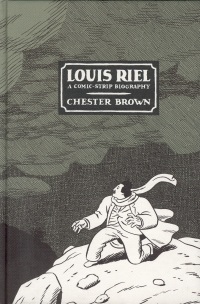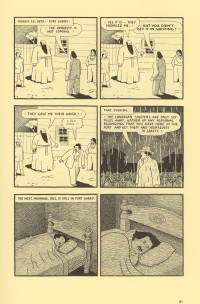| ________________
CM . . .
. Volume XI Number 21 . . . .June 24, 2005
Chester Brown celebrates the life and times of Louis Riel in this marvellous biography told in comic-strip style. The story begins with Sir John A. Macdonald, the Prime Minister of Canada, negotiating the sale of Rupert's Land from the Hudson's Bay Company, and part one ends with the execution of Thomas Scott, the arrival of the Wolseley Expedition and Riel's flight to the U.S. Part two encapsulates Riel's life from 1870 to 1876 when he moved around the northern U.S. states, afraid of being assassinated. During this time, he returned to Canada (to Montreal) where he was elected as Member of Parliament for Provencher but never took his seat as, having not been granted amnesty for Scott's death, he dreaded capture. In Montreal, the first evidence of his mental illness surfaced, and he was committed to L'Hospice St. Jean de Dieu. Part three begins with Gabriel Dumont's fight to gain good land for the Metis along the south branch of the Saskatchewan River, near Batoche. Dumont enlisted the help of Riel who was then living in Montana. Together, they led an armed rebellion against Canadian troops sent by Sir John A. MacDonald on the new CPR railway in May of 1884. They were defeated, and Riel gave himself up. Part four begins with Riel's trial, at which he was found guilty of high treason, and ends with his death by hanging. In the epilogue, we find that the rebels received amnesty, Dumont returned to Batoche, Riel's wife died, MacDonald was re-elected in 1887 and 1891, and George Stephen, the head of the CPR, died an extremely wealthy man.
The language is modern: "OKAY...RIGHT", says Sir John A. "The guns would come in handy, too," remarks Riel. "Wow," says the printer, "signed by the Queen!" This only makes the story more accessible to today's readers. When Riel speaks in English, he has a French accent: "Over t'e last several days we've agreed on a bill of rights, and t'at we should become part of Canada." His French, in brackets, is more educated and sophisticated. The vocabulary chosen delineates the characters well: the illiterate but savvy Dumont is direct, honest and forthright. Action is his middle name. "Why do decisions like this have to be made by men who live 1500 miles away? We know what our problems are. We could solve them easily," he says. Riel, who saw the big picture better, seems to hesitate, unsure of himself, unwilling for there to be bloodshed, and easily convinced to hide and run to the U.S. to avoid death. Macdonald's cavalier treatment of the Metis, his baiting of the Metis to rebel and his sophisticated back room political dealings demonstrate his determination to stay in power. Brown's research is very extensive, as can be seen by the notes in which he writes how he condensed the story and some of the characters for clarification. Although clearly sympathetic with Riel, he retains the clear eye of the thorough researcher, providing a detailed bibliography. This book is a fascinating re-telling of the critical years of Riel's life and the development of the Canadian west as a political entity. It should be a required text in the hands of every Canadian high school student, especially those from Manitoba and Saskatchewan. Highly Recommended. Joan Marshall is the teacher-librarian at Fort Richmond Collegiate in Winnipeg, MB.
To comment
on this title or this review, send mail to cm@umanitoba.ca.
Copyright © the Manitoba Library Association. Reproduction for personal
use is permitted only if this copyright notice is maintained. Any
other reproduction is prohibited without permission.
NEXT REVIEW |
TABLE OF CONTENTS FOR THIS ISSUE
- June 24, 2005.
AUTHORS |
TITLES |
MEDIA REVIEWS |
PROFILES |
BACK ISSUES |
SEARCH |
CMARCHIVE |
HOME |

 The foreword, the map section, the index and the notes section provide excellent detail that enriches the reading experience. However, Brown's amusing drawing and lettering thoroughly cover the main points of Riel's life. The characters, animals, carts, trees and buildings are drawn with a soft, rounded look reminiscent of Herges' Tintin. Point of view varies from bird's eye to landscape to close-up, both with active movement and still quiet scenes. The speech bubbles express characters' direct speech or thoughts although there are occasional explanations or dates slipped in that help to move the story along. Brackets around speech indicate French and double brackets indicate Cree, a clever way to remind the reader that English was very much a foreign language in the west at this time. The black background of the trial's panels in part four reflects the claustrophobic atmosphere of the trial room and the sad conclusion and sentencing.
The foreword, the map section, the index and the notes section provide excellent detail that enriches the reading experience. However, Brown's amusing drawing and lettering thoroughly cover the main points of Riel's life. The characters, animals, carts, trees and buildings are drawn with a soft, rounded look reminiscent of Herges' Tintin. Point of view varies from bird's eye to landscape to close-up, both with active movement and still quiet scenes. The speech bubbles express characters' direct speech or thoughts although there are occasional explanations or dates slipped in that help to move the story along. Brackets around speech indicate French and double brackets indicate Cree, a clever way to remind the reader that English was very much a foreign language in the west at this time. The black background of the trial's panels in part four reflects the claustrophobic atmosphere of the trial room and the sad conclusion and sentencing.